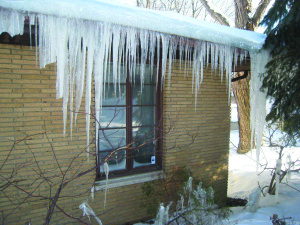 Often homeowners hunker down in winter and hold off on property maintenance issues until spring, but some issues are worth tending to in the colder months, says Dave Gustafson, Golden Valley’s property maintenance inspector.
Often homeowners hunker down in winter and hold off on property maintenance issues until spring, but some issues are worth tending to in the colder months, says Dave Gustafson, Golden Valley’s property maintenance inspector.
Weather Sealing And Rodent Blocking
Taking the time to repair holes in windows, doors, and ceilings, and using weather sealant on windows will save you a substantial amount of money on energy costs, Gustafson says.
Also, cold weather means more rodents will try to get into your home, shed, or garage, so patching up cracks, gaps, and holes helps keep them out.
“Rodents, just like us, are trying to find warm places and will look for ways to get in,” Gustafson says. “They can get through the smallest holes without too much trouble.”
There may be more holes than you think, since cold temperatures warp building materials and open gaps in unseen areas, like around the chimney flue, next to recessed lights, or in the attic.
Use caulk to weather strip windows and doors and fill skinny gaps; polyurethane foam can fill medium-sized gaps.
Lastly, attached garages should be weather-sealed. Garage doors are notorious for cold leaks, Gustafson says. Often people don’t realize how much heat energy they lose through the garage.
Ice Dams
A fully sealed and insulated attic prevents another winter weather maintenance problem: ice dams.
Ice dams form when the heat of an inadequately insulated attic causes snow to melt and trickle toward the edges of the roof. Because the attic heat does not affect the soffit near the gutters, the water refreezes and ice slowly accumulates. Subsequent melted water pools at the dam, backs up, and sometimes leaks through the roof, soffits, and gutters, creating dangerous icicles and inner-wall damage.
Snow accumulation on a roof insulates the attic below, contributing to the initial melting. This, combined with below-average temperatures, leads to ripe conditions for ice dams and headaches for homeowners.
To prevent ice dams, replace or increase the attic insulation, improve attic ventilation, and seal any air leakage paths between the house and attic. Air leaks are possible anywhere there is a penetration into the attic space around plumbing pipes, light fixtures, wiring clamps, and poorly insulated attic heat ducts.
The removal of ice dams is very dangerous, and it’s best to hire a professional to clear them, Gustafson says.
Clearing The Walk
Golden Valley City ordinances require rental property owners to clear adjacent walkways of snow, Gustafson says, and while homeowners aren’t required to do so, it’s the neighborly thing to do.
Just make sure not to pile the snow near the end of the driveway, as the high banks can obstruct your view of oncoming traffic when you back out.
Clearing snow from walkways and driveways also makes it much easier for firefighters and other emergency professionals to access your home if necessary. By the same token, clearing snow around fire hydrants can save firefighters valuable seconds in case your home catches fire.
Salt
Finally, if you’re going to use salt to melt ice from your walkways, remember that it can cause severe damage to your lawn come spring and that it is harmful to local waterways. Some types of ice-melting chemicals are easier on your lawn than others, but no matter what kind you’re using, it’s always best to follow the instructions on the container and use as little as possible, Gustafson says.
